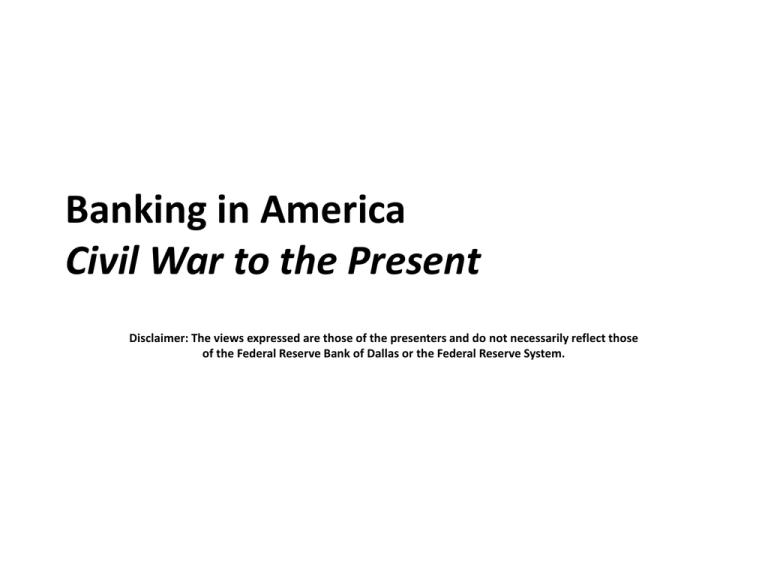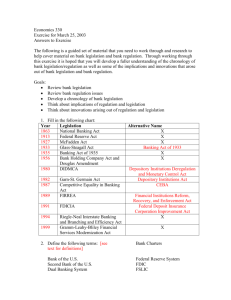Banking in America: Civil War to the Present
advertisement

Banking in America Civil War to the Present Disclaimer: The views expressed are those of the presenters and do not necessarily reflect those of the Federal Reserve Bank of Dallas or the Federal Reserve System. The End of the State Banking Era 1861 • $50M financed at different banks • Demand notes (greenbacks) are issued that are redeemable for specie “on demand” 1862 • Legal Tender Act creates United States Notes 1863 – 64 • Two National Bank Acts are passed Legal Tender Note National Bank Act • Created a uniform currency – Notes from different regions no longer discounted • Created federally chartered banks with uniform standards • Required to hold U.S. bonds as capital • Mandated supervision and examinations by Office of Comptroller of the Currency National Currency State Banks Attacked • Almost 1,600 in 1860, only 350 in 1865 • 10% tax placed on state bank notes – upheld by Supreme Court – Chief Justice Salmon P. Chase • State banks introduce demand deposits Dual banking system still exists today! Panic of 1873 • Triggered by the collapse of Jay Cooke and Co. – largest bank in the U.S. – Agent for Northern Pacific Railroad bonds • Cooke’s bank could not sell enough railroad bonds to cover obligations • Led to a sell-off in the stock market • Runs on other large financial institutions led to their failure Panic of 1893 • Sparked by failure of Philadelphia and Reading Railroad • Withdrawal of European investment led to a crisis in railroad finance • Stock market crash and a banking panic followed • Created a run on the U.S. gold supply Panic of 1907 • Knickerbocker Trust Company failed leading to runs on other trust companies • Widespread panic – Bank failures – Shrinking money supply – Deep recession • J.P. Morgan, along with other bankers, served as lender of last resort and quelled the panic The Role of a Central Bank • • • • • Issue and maintain the value of currency Supervise banks Serve as the fiscal agent for the government Conduct monetary policy Serve as a lender of last resort The Federal Reserve Act of 1913 “ to provide for the establishment of Federal reserve banks, to furnishing elastic currency, to afford means of rediscounting commercial paper, to establish a more effective supervision of banking in the United States, and for other purposes.” The Federal Reserve Today Structure of the Fed Board of Governors Daniel K. Tarullo Ben Bernanke Chairman Federal Reserve Banks Federal Open Market Committee FOMC Three Responsibilities • Supervise and Regulate Banks • Provide Financial Services • Conduct Monetary Policy Supervise and Regulate Banks • Board of Governors writes the rules that regulate financial institutions. • Reserve Banks supervise banks and enforce the rules during bank examinations. Goals of Banking Supervision and Regulation Safe and sound financial institutions Fair and equitable treatment of consumers Financial Stability Financial Services • Cash services • Electronic payments • Check processing Financial Services for the U.S. Treasury • Banking services • Issuing, transferring and redeeming U.S. government securities Economic Goals Stable prices Maximum employment Achieving Economic Goals Availability and cost of money and credit Consumer and business spending Employment and prices Tools of Monetary Policy Open Market Operations Discount Rate Reserve Requirements Interest on Reserve Balances The Great Depression Why is the “Great Depression” significant? • • • • Worst economic crisis of the 20th century Causes and cures still debated Defining event in American history Changed public’s expectations of the governments’ role in the economy Stock Market Crash of 1929 35 Sept. 1929 30 25 20 15 10 5 July 1932 0 Jan-21 Jan-23 Jan-25 Jan-27 Jan-29 Jan-31 Jan-33 Jan-35 Jan-37 Jan-39 Stock market crash of 1929 • What was the role of the stock market crash? – Destroyed wealth – Reduced trust in the health of the financial system – Economic uncertainty (constrained spending) • Probably had some effect, but not big enough by itself to cause depression. Three Schools of Thought • Keynesian explanation • Monetarist explanation • International explanation John Maynard Keynes (1883—1946) • British economist • Principal representative for the British Treasury at Versailles – anticipated burden of reparation debt on Germany • Represented U.K. at Bretton Woods Conference after WWII Keynesian Explanation Keynes advocated government spending to break this cycle. Output falls Prices fall Consumer spending falls Revenue falls Wages and employment down Monetarist explanation • Shrinking supply of money and credit deepened and lengthened the Great Depression • Landmark book in 1963, A Monetary History of the United States, by Milton Friedman and Anna Schwartz Monetarist Explanation Withdrawn deposits Bank failures Loan defaults Prices and employment fall Bank reserves fall Fewer loans Spending falls Where was the Fed? • Failed to serve as lender of last resort – Prevailing thought that failing banks should be allowed to fail – Many failed banks were small, nonmember banks – Few banks borrowed at the discount window • Raised interest rates in support of the gold standard International explanation • Nations around the world experienced a downturn • Protectionist “beggar-thy-neighbor” tariffs – Smoot-Hawley tariff in the U.S. • International gold standard The Collapse of World Trade $ value imports of 75 countries Smoot-Hawley Tariffs • Increased the cost of imported goods • Retaliatory measures from trading partners – which dried up foreign markets left products with nowhere to go. • Trade collapsed world wide – not just an American phenomena Gold Standard • International system of fixed exchange rates • Domestic impact of global standard through gold as reserves in the bank system • Federal Reserve supported the gold standard Supporting the Gold Standard • Allow gold to flow out of the country → bank lending is constrained • Raise interest rates → attract international investment and gold How do these affect bank lending and consumer and business spending? Since the Great Depression • Treasury-Fed Accords (1951) • Humphrey-Hawkins Act (1977) Questions?











